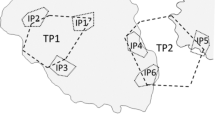Abstract
Males of the herbivorous cichlid fishPseudosimochromis curvifrons established mating territories 3–10 m in diameter, which included both spawning and feeding sites. Territorial males attacked conspecific males and also other species. Only conspecific males were chased out of the territories. Territorial males attacked other species at the spawning sites while courting or waiting for females and at other sites in their territories while patrolling and foraging. Attacks against herbivorous species were more frequent than against non-herbivores since herbivores were much more abundant. Territories of four abundant herbivorous cichlids largely overlapped the territories ofP. curvifrons males. Symbiotic relationships were not detected between the species. Instead, they were aggressive towards each other but coexisted by segregating feeding sites in the overlapping areas. The aggressive coexistence ofP. curvifrons males with other herbivores may have resulted from the energetic costs of defending their relatively large territories against all food competitors. Interspecific food-resource partitioning may also have facilitated the coexistence.
Similar content being viewed by others
References
Brichard P. (1978)Fishes of Lake Tanganyika. 448pp. T.F.H. Publ., Neputune City, N.J.
Brown J. L. &Orians G. H. (1970) Spacing patterns in mobile animals.Ann. Rev. Ecol. Syst. 1:239–62.
Kawanabe H. (1972) An volutionary aspect of the territoriality of Ayu-fish,Plecoglossus altielis, with the social structure at the southern end of its distribution.Jap. J. Ecol. 22:141–9 (in Japanese with English summary).
Kawanabe H. (1981) Territorial behaviour ofTropheus moorei (Osteichthyes: Cichlidae) with a preliminary consideration on the territorial forms in animals.Afr. Stud. Monogr. 1:101–8
Kohda M. (1984) Intra- and interspecific territoriality of a temperate damselfishEupomacentrus altus. (Teleostei: Pomacentridae).Physiol. Ecol. Japan 21: 35–52.
Kohda M. (1989) Intra-and interspecific social organization among three herbivorous cichlid fishes in Lake Tanganyika. 43pp. PhD thesis, Kyoto University (unpubl.)
Kuwamura T (1986) Parental care and mating systems of cichlid fishes in Lake Tanganyika: a preliminary field survey.J. Ethol. 4:129–46.
Kuwamura T. (1987) Male mating territory and sneaking in a maternal mouthbrooder,Pseudosimochromis curvifrons (Pisces; Cichlidae).J. Ethol. 5: 203–6.
Kuwamura T. (1991) Habitat segregation, coexistence or interspecific territoriality between two triggerfishes,Rhinecanthus aculeatus andSufflamen chrysopterus, with notes on distribution of other balistids at Sesoko Island, Okinawa.Galaxea 10:65–78.
Murray B. G. (1981) The origins of adaprive interspecific territorialism.Biol. Rev. 56:1–22.
Nelissen M. H. J. (1979) A taxonomic revision of the generaSimochromis, Pseudosimochromis andTropheus (Pisces, Cichlidae).Ann. Mus. R. Afr. Centr. in-8, Sc. Zool. 229:1–54.
Orians G. H. &Willson M. F. (1964) Interspecific territories of birds.Ecology 45:736–45.
Reinthal P. N. (1990) The feeding habits of a group of herbivorous rock-dwelling cichlid fishes (Cichlidae: Perciformes) from Lake Malawi, Africa.Envir. Biol. Fish. 27:215–33.
Robertson D. R. &Polunin N. V. C. (1981) Coexistence: symbiotic sharing of feeding territories and algal food by some coral reef fishes from the Western Indian Ocean.Mar. Biol. 62:185–95.
Robertson D. R., Polunin N. V. C. &Leighton K. (1979) The behavioral ecology of three Indian Ocean surgeonfishes (Acanthurus lineatus, A. leucosternon andZebrasoma scopas): Their feeding strategies, and social and mating systems.Envir Biol. Fish. 4: 125–70.
Takamura K. (1983) Interspecific relationship between two aufwuchs eatersPetrochromis polyodon andTropheus moorei (Pisces Cichlidae) of Lake Tanganyika, with a discussion on the evolution and functions of a symbiotic relationship.Physiol. Ecol. Japan 20:59–69.
Takamura K. (1984) Interspecific relationships of aufwuchs-eating fishes in Lake Tanganyika.Envir. Biol. Fish. 10:225–41
Thresher R. E. (1976) Fiel analysis of the territoriality of the threespot damselfish,Eupomacentrus planifrons (Pomacentridae).Copeia 1976:266–76.
Wilson E. O. (1975)Sociobiology: The New Synthesis. 697 pp. Belknap, Harvard University Press, Cambridge.
Yamaoka K. (1982) Morphology and feeding behaviour of five species of genusPetrochromis (Teleostei, Cichlidae).Physiol. Ecol. Japan 19:57–75.
Author information
Authors and Affiliations
About this article
Cite this article
Kuwamura, T. Overlapping territories ofPseudosimochromis curvifrons males and other herbivorous cichlid fishes in Lake Tanganyika. Ecol. Res. 7, 43–53 (1992). https://doi.org/10.1007/BF02348596
Accepted:
Issue Date:
DOI: https://doi.org/10.1007/BF02348596




